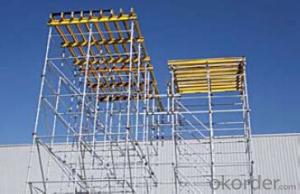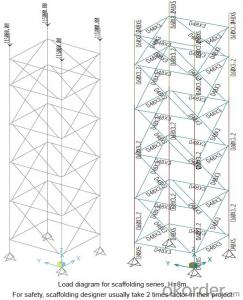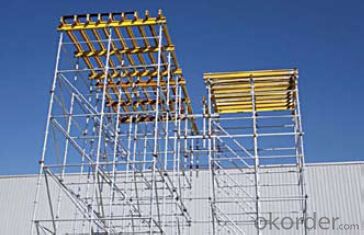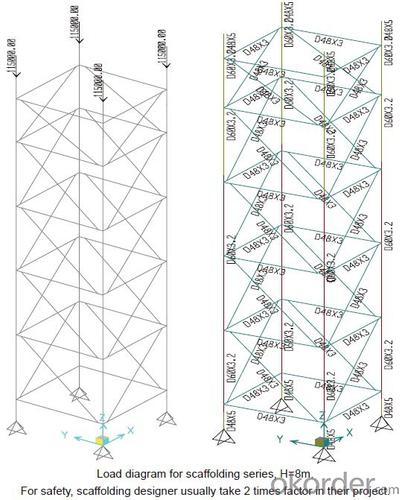Ring-lock Scaffolding Accessories for formwork and scaffolding systems
- Loading Port:
- Tianjin
- Payment Terms:
- TT OR LC
- Min Order Qty:
- 50 m²
- Supply Capability:
- 1000 m²/month
OKorder Service Pledge
Quality Product, Order Online Tracking, Timely Delivery
OKorder Financial Service
Credit Rating, Credit Services, Credit Purchasing
You Might Also Like
Ring-lock Scaffolding
A support system for construction, ownsadvantages of both cup-lock scaffolding andshoring tower.
It is in the development direction of new typescaffolding.
It is widely used in buildings, bridges, tunnels etc..
Characteristics:
◆ Easy to storage and transportation
◆ High degree of standardization
◆ Easy and quick erection
◆ Excellent stability and bearing capacity
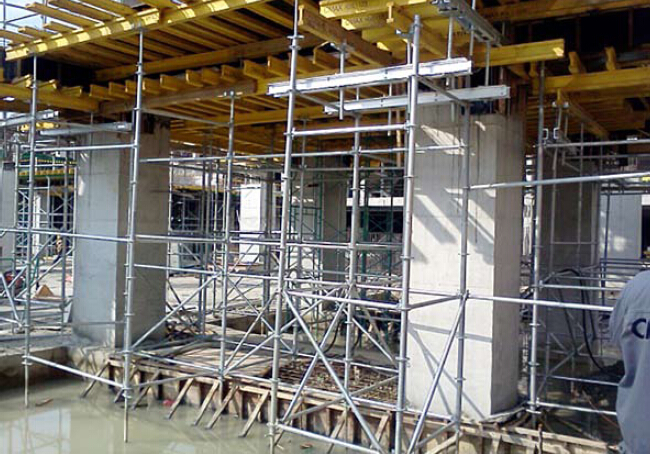
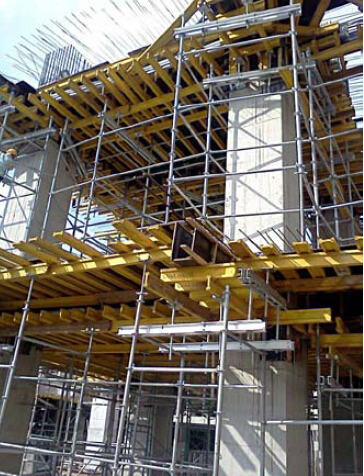
- Q: How do steel formwork systems ensure proper alignment and stability?
- Steel formwork systems ensure proper alignment and stability through various features and design elements. Firstly, steel formwork systems are made of high-quality steel materials that offer excellent strength and durability. This ensures that the formwork maintains its shape and structure even under heavy loads and adverse weather conditions. Additionally, steel formwork systems often incorporate interlocking mechanisms and connecting devices that securely hold the formwork panels together. These connections provide a tight and precise alignment, ensuring that the formwork maintains its shape and prevents any movement or shifting during the concrete pouring process. Furthermore, steel formwork systems are typically designed with adjustable components, such as adjustable struts or props, which allow for easy and accurate leveling and alignment. These adjustable elements enable workers to fine-tune the formwork to the desired position and ensure a level and uniform concrete surface. Moreover, steel formwork systems often include diagonal bracing or cross-bracing elements that provide added stability and rigidity. These bracing elements help distribute the load evenly across the formwork, minimizing any potential sagging or deformation and ensuring the stability of the structure during the concrete pouring and curing process. Lastly, steel formwork systems are versatile and can be customized to fit various shapes and sizes. This flexibility allows for precise alignment to the desired form, ensuring that the concrete structure is constructed with the utmost accuracy and stability. In conclusion, steel formwork systems ensure proper alignment and stability through the use of high-quality materials, interlocking mechanisms, adjustable components, bracing elements, and customization options. These features work together to create a reliable and robust formwork system that guarantees the accurate and stable construction of concrete structures.
- Q: Can steel formwork be used for architectural concrete slabs with embedded elements?
- Yes, steel formwork can be used for architectural concrete slabs with embedded elements. Steel formwork provides a strong and durable framework for pouring and shaping concrete. It allows for precise and accurate placement of embedded elements such as pipes, electrical conduits, and reinforcement bars. Steel formwork also offers the advantage of reusability, making it a cost-effective choice for construction projects. Moreover, the smooth surface of steel formwork can result in a high-quality finish for architectural concrete slabs.
- Q: How does steel formwork contribute to the overall efficiency of concrete placement?
- Steel formwork plays a crucial role in enhancing the overall efficiency of concrete placement. Firstly, steel formwork is highly durable and can withstand the pressure exerted by fresh concrete. This durability ensures that the formwork remains intact during the pouring and curing process, thereby minimizing the need for repairs or replacements. Consequently, the construction process can proceed smoothly without delays, resulting in improved efficiency. Additionally, steel formwork is known for its high strength and stability. This allows for the construction of larger and taller concrete structures, as the formwork can support the weight and pressure of the concrete without buckling or deforming. With steel formwork, contractors have the flexibility to construct complex shapes and designs, enabling them to meet specific architectural requirements efficiently. Moreover, steel formwork offers easy and precise assembly. Its modular nature allows for quick installation and dismantling, reducing construction time significantly. The standardized components ensure that the formwork is accurately aligned, leading to consistent and uniform concrete placement. This not only enhances the efficiency of the construction process but also contributes to the quality and aesthetics of the final concrete structure. Furthermore, steel formwork is reusable. Unlike traditional timber formwork, steel formwork can be utilized multiple times, reducing material waste and saving costs. The ability to reuse the formwork eliminates the need for constant procurement and disposal of materials, streamlining the construction process and improving overall efficiency. Lastly, steel formwork provides a smooth finish to the concrete surface. The rigid structure of steel formwork prevents any bulges or deformities, resulting in a flat and even concrete surface. This eliminates the need for additional surface treatments, such as plastering or grinding, saving time and resources. The smooth finish not only enhances the aesthetic appeal of the concrete structure but also improves its durability and longevity. In conclusion, steel formwork significantly contributes to the overall efficiency of concrete placement. Its durability, strength, easy assembly, reusability, and ability to provide a smooth finish make it an invaluable tool in the construction industry. By utilizing steel formwork, contractors can expedite the construction process, reduce material waste, and achieve high-quality concrete structures efficiently.
- Q: Can steel formwork be used for high-rise buildings?
- Yes, steel formwork can be used for high-rise buildings. Steel formwork is known for its durability, strength, and ability to withstand high concrete pressures. These characteristics make it suitable for constructing tall structures such as high-rise buildings. Steel formwork systems are designed to provide stability and support during the construction process, ensuring that the concrete is properly shaped and cured. Additionally, steel formwork can be easily assembled and disassembled, allowing for efficient construction and adaptability to different project requirements. Overall, steel formwork is a reliable and commonly used solution for high-rise building construction.
- Q: Are there any specific considerations for using steel formwork in areas with high seismic activity?
- Yes, there are several specific considerations for using steel formwork in areas with high seismic activity. Firstly, steel formwork is known for its strength and durability, which makes it suitable for withstanding seismic forces. However, in high seismic areas, it is crucial to ensure that the steel formwork is properly designed and constructed to withstand the expected level of seismic activity. This may involve using thicker steel plates or additional reinforcement to enhance the formwork's resistance to seismic forces. Secondly, it is important to consider the connections and joints between different sections of steel formwork. In areas with high seismic activity, these connections should be designed and constructed to be flexible and able to absorb and dissipate seismic energy. This can be achieved through the use of specialized connectors, such as seismic expansion joints or flexible fasteners, which allow for controlled movement during an earthquake. Additionally, proper bracing and anchoring of the steel formwork is essential in high seismic areas. Bracing systems should be designed to provide stability and prevent the formwork from collapsing or tipping over during an earthquake. Anchoring the formwork to the ground or other structural elements can further enhance its stability and resistance to seismic forces. Moreover, it is important to consider the weight and mass of the steel formwork in seismic design. The weight of the formwork can affect the overall stability of the structure during an earthquake. Therefore, it is crucial to ensure that the weight of the formwork is properly accounted for in the seismic design calculations. Lastly, regular inspections and maintenance of the steel formwork are necessary to ensure its continued effectiveness and safety in high seismic areas. Inspections should be conducted to identify any potential damage or deterioration that may have occurred due to seismic activity. Any repairs or reinforcements should be promptly carried out to maintain the integrity and performance of the formwork system. In summary, when using steel formwork in areas with high seismic activity, specific considerations such as proper design, flexible connections, bracing and anchoring, weight calculation, and regular inspections should be taken into account to ensure the safety and effectiveness of the formwork system.
- Q: Can steel formwork be used for precast concrete arches?
- Yes, steel formwork can be used for precast concrete arches. Steel formwork is a versatile and durable material that can be used to create complex shapes and structures, including arches. Steel formwork provides excellent support and stability during the casting process, allowing for the precise and accurate formation of arches. Additionally, steel formwork can be easily customized and adjusted to accommodate different arch designs and dimensions. Its strength and rigidity make it suitable for withstanding the pressure and weight of the concrete during the curing process. Therefore, steel formwork is a preferred choice for constructing precast concrete arches due to its flexibility, strength, and reliability.
- Q: What are the different types of steel formwork available?
- In the construction industry, there exists a variety of steel formwork options, each possessing its own distinctive characteristics and benefits. Some of the most prevalent variations include: 1. Modular steel formwork: This formwork type comprises pre-made steel panels that can be effortlessly assembled and disassembled. It boasts customization capabilities and can accommodate concrete structures of diverse shapes and sizes. 2. Tunnel formwork: Specifically designed for tunnel and underground structure construction, this formwork variant is forged from steel plates. Its robust construction enables it to withstand high pressure and deliver a polished finish to the concrete. 3. Climbing formwork: Tailored for tall structures such as skyscrapers, climbing formwork is engineered to be lifted and moved vertically as construction progresses. This type of formwork ensures both safety and efficiency during the construction of multi-story buildings. 4. Steel soldier formwork: A versatile and cost-effective option often employed for walls and columns, steel soldier formwork is constructed using steel beams and soldiers. It can be easily adjusted to accommodate different heights and widths. 5. Steel frame formwork: Comprised of steel frames with attached plywood or metal panels, this lightweight formwork type is easy to handle and guarantees a smooth concrete finish. 6. Steel table formwork: Ideal for large horizontal slabs, steel table formwork utilizes steel tables supported by props or scaffolding. Its quick assembly and dismantling make it perfect for projects with tight timelines. These examples represent only a fraction of the available steel formwork options. The selection of formwork depends on project-specific requirements, including the structure type, load-bearing capacity, and desired finish.
- Q: Can steel formwork be used for precast concrete beams?
- Indeed, precast concrete beams can utilize steel formwork. Demonstrating durability and rigidity, steel formwork effectively endures the weight and pressure exerted by the concrete during casting. It furnishes a seamless and uniform surface to facilitate pouring the concrete, guaranteeing the anticipated shape and dimensions of the beam. Moreover, steel formwork enables effortless demolding and reusability, rendering it a financially prudent option for manufacturing precast concrete beams.
- Q: Can steel formwork be used for road construction?
- Yes, steel formwork can be used for road construction. Steel formwork is a popular choice for road construction projects due to its durability, strength, and versatility. It is capable of withstanding heavy loads and pressure, making it suitable for creating sturdy and long-lasting road surfaces. Steel formwork can be easily assembled and disassembled, allowing for efficient construction processes and faster project completion. Additionally, steel formwork can be reused multiple times, making it a cost-effective option for road construction.
- Q: How does steel formwork affect the overall construction timeline?
- Steel formwork can significantly affect the overall construction timeline in several ways. Firstly, steel formwork is known for its durability and strength, allowing for faster and more efficient construction processes. Unlike traditional timber formwork, steel formwork can be reused multiple times, reducing the time and effort required for dismantling and reassembly. This reusability not only saves time but also minimizes the need for additional materials, thereby reducing construction waste and costs. Additionally, steel formwork provides greater flexibility in terms of design and customization. Its versatility allows for complex shapes and structures to be easily created, reducing the need for extensive modifications or adjustments during the construction process. This flexibility not only saves time but also enhances the overall construction efficiency. Moreover, steel formwork offers quicker curing times for concrete, as it provides better temperature and moisture control. This accelerates the process of concrete setting and reduces the time required for form removal. Consequently, the construction timeline is shortened, enabling subsequent construction activities to commence earlier. Furthermore, steel formwork is known for its high load-bearing capacity, enabling multiple floors to be constructed simultaneously. This parallel construction approach can significantly expedite the construction process, thereby reducing the overall timeline. However, it is important to note that while steel formwork offers numerous advantages, its initial setup and installation may require more time compared to other formwork materials. The steel formwork system needs to be properly aligned and secured, which might take longer than setting up traditional timber formwork. However, this initial time investment is often offset by the time saved during subsequent construction stages. In conclusion, steel formwork can have a positive impact on the overall construction timeline. Its durability, reusability, versatility, quicker curing times, and high load-bearing capacity contribute to faster construction processes, reduced material waste, and increased construction efficiency. Despite the initial setup time, the benefits of steel formwork ultimately result in a more streamlined and accelerated construction timeline.
Send your message to us
Ring-lock Scaffolding Accessories for formwork and scaffolding systems
- Loading Port:
- Tianjin
- Payment Terms:
- TT OR LC
- Min Order Qty:
- 50 m²
- Supply Capability:
- 1000 m²/month
OKorder Service Pledge
Quality Product, Order Online Tracking, Timely Delivery
OKorder Financial Service
Credit Rating, Credit Services, Credit Purchasing
Similar products
Hot products
Hot Searches
Related keywords
